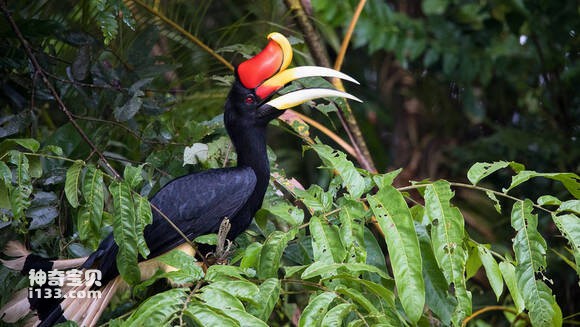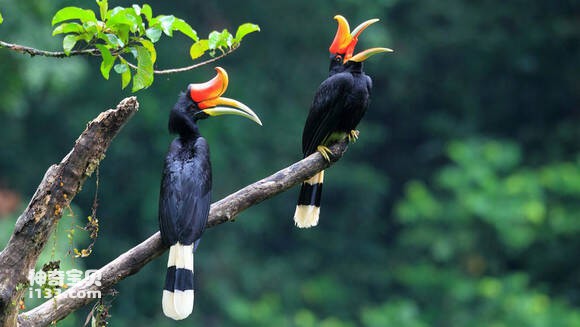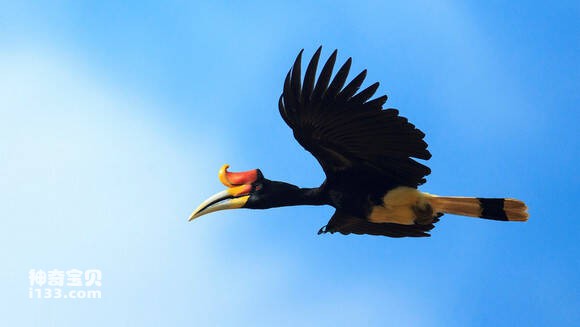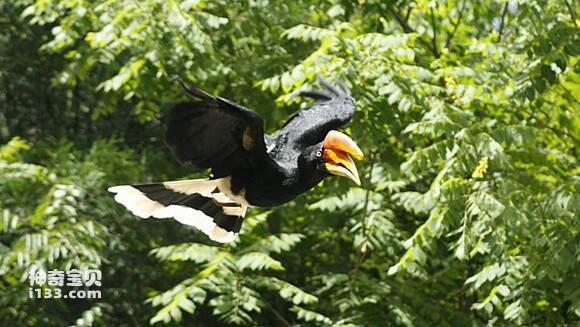Buceros rhinoceros
IUCN
LCBasic Information
Scientific classification
- name:Buceros rhinoceros
- Scientific Name:Buceros rhinoceros,Rhinoceros Hornbill
- Outline:Climbing birds
- Family:
Vital signs
- length:110-122cm
- Weight:2.36-2.91kg
- lifetime:About 35 years
Feature
National bird of Malaysia
Distribution and Habitat
The Malaysian hornbill is found in Brunei, Indonesia, Malaysia and Thailand. Regional extinction: Singapore.
The Malaysian hornbill lives in a large area of primary forest. It relies on the favorable height of the trees to select its nesting sites. Its movements are erratic, and the primary condition of the environment is the availability of food in all seasons and the ability to provide a wide variety of fruits and berries. It also occurs in forested areas on the slopes of hills.
Appearance
The Malaysian hornbill has a body length of 110 ~ 122 cm with a wingspan of 152 cm. The male bird weighs 2.91 kg and the female bird weighs 2.36 kg. The mouth is thick and straight, usually with a helmet and a strong tip curved upward, so named for the shape of a rhinoceros horn. Syndactyly. The bill and helmet of the hornbill are white, but for most of their lives, they constantly rub the glands with the bill to secrete a liquid, which is located directly below the tail, and which appears orange and red in color. The bottom of the head, neck, upper body, wings, chest, and thighs form large patches of black with a bluish tinge. The thigh, lower abdomen, anal area, underside tail, buttocks and upper tail cover are white. The tail is pure white with broad black stripes that make up two-thirds of its length. Iris is red with black circles; Red eyelashes; The feet and tarsus are brown and black. The female bird's body feathers are identical to those of the male bird, the only differen
Details
Buceros rhinoceros and Rhinoceros Hornbill have three subspecies (1. Buceros rhinoceros borneoensis. 2. The Malay hornbill is named Buceros rhinoceros rhinoceros. 3. Buceros rhinoceros silvestris, the Javan subspecies of the hornbill.) .

Malaysian hornbills often sing in small groups as they search for food over large hectares of forest. In groups, couples stay together only during the breeding season, when both sexes are fiercely territorial and powerful calls sound like advocacy to prove their presence. Feeding on ripe fruit, insects, small lizards, and even small birds, hornbills often follow groups of monkeys in order to find ripe fruit, and animal ingredients make up about 30 percent of their food source.

The Malaysian hornbill attaches great importance to showing love, and the male must be trusted by the female before mating, laying, brooding and raising chicks. Nesting and spawning season from January to April, choose a tall trunk about 16 to 33 meters away from the ground in the tree hole for the nest, they do not peck wood, are the use of natural decay or termite invasion and bite of the cave. The breeding habit of hornbills is very special, the female bird chooses the nest site, lays a layer of wood chips at the bottom of the hole, and lays 1 to 2 pure white eggs in the hole. After laying eggs, squatting in the nest no longer goes out, and piles his excreta mixed with seeds and rotten wood in the hole. Male birds from outside the nest frequently bring wet mud, fruit residue, to help female birds seal the hole. The material that seals the tree hole seeps through the viscous stomach juices of the female bird, so it is very strong. Finally, a vertical gap is left in the hole for the female to reach out to the male for feeding. The female stays in the hole for months, only to escape when the chicks are ready to fly. Incubation lasts 37 to 42 days. They remain in the shelter for up to three months after the chicks hatch. In the meantime, the males feed. Male birds can peel off the innermost layer of the stomach wall and spit it out in a thin film, which is used to store fruit for female birds and young birds to eat. The female bird comes out of the hole with new feathers and is immediately responsible for feeding her chicks. Female birds in the closed cave, but also from time to time to clean feces and other dirt, it directly throws out the hole with its mouth, when it defecates itself, the anus directly sprayed out of the hole, this strange way of life, may be the harm of natural enemies, and with the harsh natural environment to fight against the formation of adaptation.

Malaysia is the home of hornbills, so it has been known as the "land of hornbills" for more than 100 years. It can be seen that the reason why the national bird of Malaysia is the hornbill is because the number of hornbills in its territory is very large and has a long history. The Malaysian Olympic Committee also chose the hornbill, Malaysia's key protected animal, as the prototype mascot for Shenya. In addition, hornbill is a beautiful shape and colorful bird, which is loved and worshipped by Sarawak people, and is the divine bird in the minds of locals. It was considered a great honor to have as many carvings of hornbills as possible in the longhouse where they lived. They considered these ornate and colorful carvings to be the best tribute to the gods, and the carvings of hornbills were a necessary ritual at the annual "Bird Festival".

Listed in Appendices I, II and III of the Convention on International Trade in Endangered Species of Wild Fauna and Flora (CITES) 2019 edition Appendix II.
Listed on the IUCN Red List of Threatened Species (IUCN) ver 3.1:2020 - Vulnerable (VU).
Protect wild animals and eliminate wild meat.
Maintaining ecological balance is everyone's responsibility!








